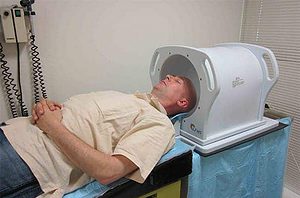
Promising results are reported by physicians who incorporate magnetic stimulation in their treatments for depression. Typically, this kind of treatment takes a long time until changes in mood are seen or, in some cases, causes unwanted side effects. McLean Hospital researchers report a new treatment that uses low field magnetic stimulation that immediately improves mood and isn’t followed by side effects that the researchers know of.
“LFMS is unlike any current treatment. It uses magnetic fields that are a fraction of the strength but at a higher frequency than the electromagnetic fields used in TMS [transcranial magnetic stimulation] and ECT [electroconvulsive therapy],” explained first author Michael Rohan, a physicist at McLean Hospital’s Brain Imaging Center and a lecturer at Harvard Medical School.
The most common tool for treating the clinically depressed is antidepressant medication, but typically it takes four to six weeks before mood changes are detected. Magnetic stimulation is a novel technique that’s only recently beginning to be recognized, yet even these take long to impact mood, and ECT is associated with side effects such as memory loss.
“Importantly, LFMS appears to have an immediate effect on mood and thus has the potential to provide relief in emergency situations,” explained Rohan, who first reported the potential use of LFMS to treat depression in a groundbreaking study in 2004. “In addition to providing quick relief from symptoms, the other exciting piece about LFMS is that no side effects have been observed.”
The team of researchers employed a portable LFMS station that Rohan designed himself on 63 volunteers between the ages of 18 and 65, all whom were diagnosed with either major depressive disorder or bipolar disorder and had been on a regimen of antidepressants or mood-stabilizing medications for at least six weeks. The participants were divided in two: 34 participants who received active LFMS treatment and 29 who went through the process but never received any actual stimulation. The participants were randomized and the researchers who analyzed the data were not aware which participants belonged to which group.
Each participant rated his or her mood before and after the single 20-minute treatment using two common self-assessment tools: a visual analog scale and the positive and negative affect schedule. Participants who received the LFMS treatment indicated a marked improvement in their mood, while those whose brains were not stimulated reported no change in mood.
“We observed immediate improvement in mood following relatively brief exposure to LFMS,” noted Rohan. “Although larger research studies are needed, we think LFMS could be a powerful tool as a rapidly acting treatment for depression, either alone or in combination with medication.”
The next step is to devise a new study using a more extensive sample size to see whether or not the results can be replicated. Also, a new research is already underway that is designed to assess how multiple sessions compare to a single one and measure how long the antidepressant effects last following treatment.
The findings appeared in the journal Biological Psychiatry.


